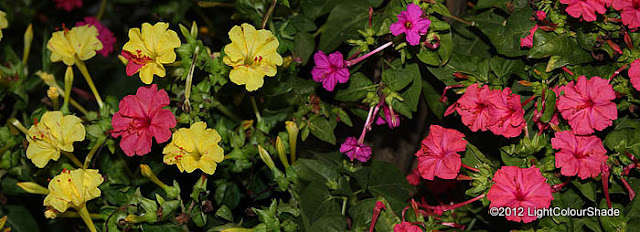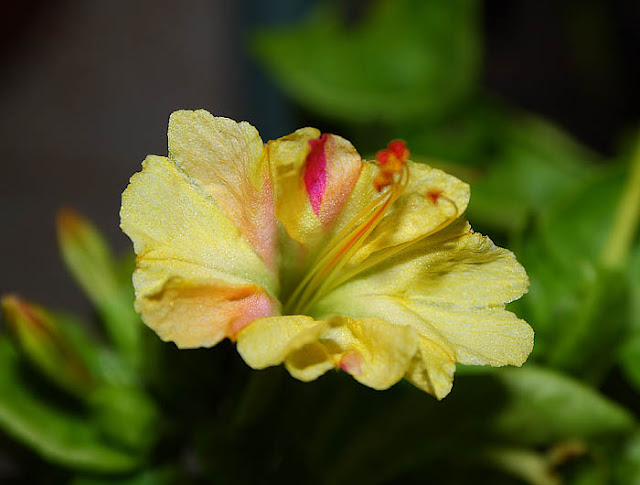What I especially love about these flowers is their random colouring — flowers of different colours can be found simultaneously on the same plant and an individual flower can be splashed with different colours as if God or an invisible painter had taken a brush and coloured the flowers at their whim with watercolour touches.
But the peculiarities don't end here, the most unusual trait being the plant's colour-changing phenomenon. For example, in the yellow variety, as the plant matures, it can display flowers that gradually change to a dark pink colour. Similarly white flowers can change to light violet. The plant creates a wide range of 'Broken Colours': from all sorts of combinations of yellow, white, purple, deep pink or red petals to watered down purple, red or yellow flowers stippled with yellow, white or purple.
Yet another curious aspect of this plant is that, when red-flowered plants are crossed with white-flowered plants, pink-flowered offspring, not red, are produced. Similarly, when yellow-flowered plants are crossed with red or purple-flowered plants the offspring are pale orange-flowered. This is an exception to Mendel's Law of Dominance, because in this case the red, yellow and white genes are of equal strength, so none completely dominates the other. The phenomenon is known as incomplete dominance.
Moreover, the plant isn't just a pretty face — an edible crimson dye obtained from the flowers is used in food colouring. The leaves may be eaten cooked as well, although only as an emergency food.
It also has medicinal properties — parts of the plant may be used as a diuretic, purgative, and for vulnerary (wound healing) purposes (leaf juice may be used to treat wounds). The leaves are also used to reduce inflammation and decoction of them (mashing and boiling) is used to treat abscesses. The root is believed an aphrodisiac, as well as diuretic and purgative.
The only downside is that each individual flower blooms for just a day (an afternoon, to put it more exactly), lasts all night and then wilts.
Anyway, enjoy their beauty.
 |
| Mirabilis jalapa (The four o'clock flower), yellow pink purple (© 2012 LightColourShade. All rights reserved) |
 |
| Mirabilis jalapa (The four o'clock flower) yellow pink and purple flowers (© 2012 LightColourShade. All rights reserved) |
 |
| Mirabilis jalapa (The four o'clock flower) deep pink flowers (© 2012 LightColourShade. All rights reserved) |
+pale+yellow+broken+colour+flower.jpg) |
| Mirabilis jalapa (The four o'clock flower) pale yellow broken colour flower (© 2012 LightColourShade. All rights reserved) |
+pale+yellow+flowers.jpg) |
| Mirabilis jalapa (The four o'clock flower) pale yellow flowers (© 2012 LightColourShade. All rights reserved) |
Variegated flowers on a four o'clock plant.
+pale+yellow-pink+flowers+close-ups.jpg) |
| Mirabilis jalapa (The four o'clock flower) pale yellow-pink flowers close-ups (© 2012 LightColourShade. All rights reserved) |
+pink+flowers+close-up.jpg) |
| Mirabilis jalapa (The four o'clock flower) pink flowers close-up (© 2012 LightColourShade. All rights reserved) |
+yellow+and+pink.jpg) |
| Mirabilis jalapa (The four o'clock flower) yellow and pink (© 2012 LightColourShade. All rights reserved) |
+yellow+pink+broken+colours+flowers.jpg) |
| Mirabilis jalapa (The four o'clock flower) yellow pink broken colours flowers (© 2012 LightColourShade. All rights reserved) |
A wonderful set of photos, and a wonderful discussion. I remember the flowers from my one trip to Mexico, and I thought at that time that they seemed especially and exuberantly wonderful, even in the most depressing households.
ReplyDeleteAs usual, you've grasped the main point of the post -- these flowers convey joy.
DeleteIt's root. food or not? ?
ReplyDelete